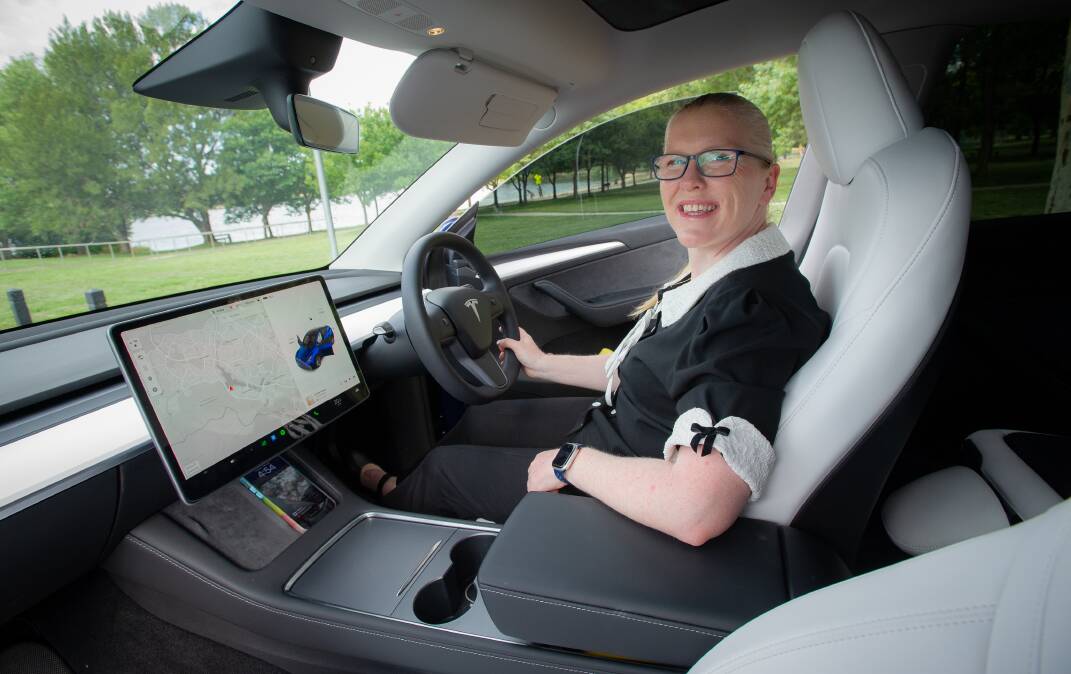
Reckon you've seen more electric vehicles on our roads recently? You probably have.
Almost 10 per cent of cars sold in the ACT in 2022 were electric vehicles, representing an 80 per cent increase on sales the year prior.
There were more than 1500 electric vehicles sold in the ACT in 2022, compared to 825 sold here in 2021, new data issued by the Electric Vehicle Council has revealed.
Kristy, who asked her last name not be used, purchased a Tesla Model 3 in 2020. Since then she's upgraded to the Model Y and the family has purchased a second electric vehicle for her husband.
"Prior to owning a Tesla, a car just got you from A to B and it did its job, but a Tesla's just a joy to drive," Kristy said.
"I love that I can drive around with zero emissions."
Tesla's entry-level vehicle, the Model 3, was the most popular with ACT buyers in 2022 with 426 sold. The Model Y, which retailed for around $74,000 at the time, was the second most popular with 299 sold.
The Tesla trend was echoed across Australia, with electric vehicle ownership climbing across the country.
The number of electric vehicles on Australia's roads almost doubled in the 12 month period, growing from 44,000 in 2022 to more than 83,000.
While the ACT continues to lead the nation in terms of market share at 9.7 per cent, both NSW and Victoria effectively doubled market share to achieve four per cent of new vehicle purchases in 2022, with Tasmania at 3.7 per cent, Queensland at 3.5 per cent and Western Australia's 3.4 per cent not far behind.
Behyad Jafari, Electric Vehicle Council, Chief Executive Officer, said the ACT, alongside NSW, is doing more than other jurisdictions to encourage people to buy or use an electric vehicle.
"Importantly, the ACT has been doing it for longer, so it's given people in Canberra more time to become familiar with the types of government programs available, more time for things like charging infrastructure to be built," he said.
"As a result, what we see is that the ACT is performing about three times better than some other states."
The ACT government delivered its Zero Emissions Vehicle strategy in 2022, which included an aspirational target of 80 to 90 per cent of light-vehicle sales consisting of zero-emissions vehicles by 2030, and a phase-out of internal combustion engine vehicle sales from 2035.
There were 38 public charging stations in the ACT at the end of 2022. The network was expected to expand to 100 in 2023, the Electric Vehicle Council said.
Mr Jafari said while cost and shortfalls in the national charging system were still a barrier for purchasing an electric vehicle for some people, the real barrier was supply.
He said the introduction of fuel-efficiency standards, regulatory standards other countries have in place requiring companies to bring fuel-efficient hybrid and electric vehicles to the market or face penalties, were required at a federal level if Australia was going to catch up.
"Often what we saw was that when a company would make its electric vehicle available for sale, usually that makes them available online, they would sell out within hours," Mr Jafari said.
Mr Jafari said there was a manufacturing opportunity for Australia too, if regional partnerships were formed with places like Thailand and Indonesia.
"There's a very strong opportunity there for us to be building electric-vehicle batteries and selling those batteries to companies building the rest of the vehicle," he said.
"The metals that go into the battery come from Australia.
"Then there's also, a more difficult, but still potential there for us to also do electric-vehicle manufacturing. There is already some level occurring, but we can do it at a much larger scale, particularly with light vehicles."
We've made it a whole lot easier for you to have your say. Our new comment platform requires only one log-in to access articles and to join the discussion on The Canberra Times website. Find out how to register so you can enjoy civil, friendly and engaging discussions. See our moderation policy here.







